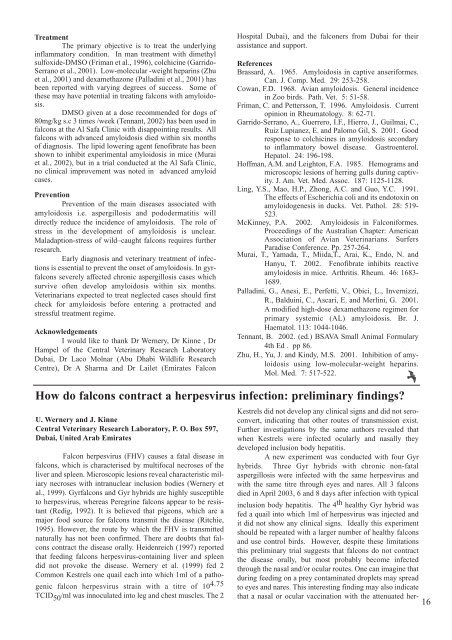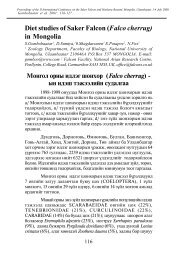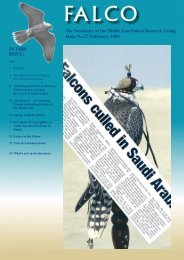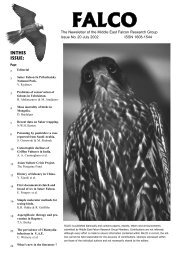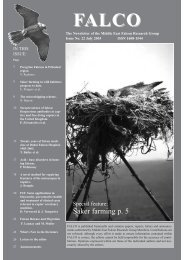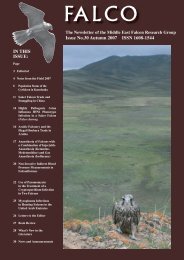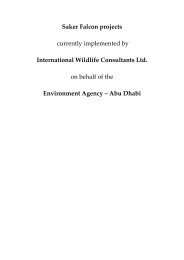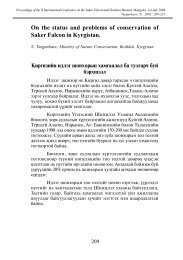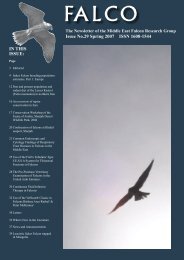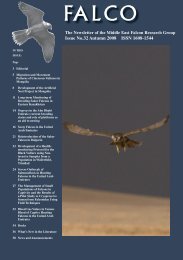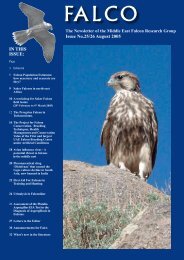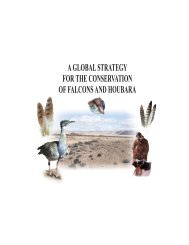Falco cherrug - International Wildlife Consultants Ltd.
Falco cherrug - International Wildlife Consultants Ltd.
Falco cherrug - International Wildlife Consultants Ltd.
You also want an ePaper? Increase the reach of your titles
YUMPU automatically turns print PDFs into web optimized ePapers that Google loves.
Treatment<br />
The primary objective is to treat the underlying<br />
inflammatory condition. In man treatment with dimethyl<br />
sulfoxide-DMSO (Friman et al., 1996), colchicine (Garrido-<br />
Serrano et al., 2001). Low-molecular -weight heparins (Zhu<br />
et al., 2001) and dexamethazone (Palladini et al., 2001) has<br />
been reported with varying degrees of success. Some of<br />
these may have potential in treating falcons with amyloidosis.<br />
DMSO given at a dose recommended for dogs of<br />
80mg/kg s.c 3 times /week (Tennant, 2002) has been used in<br />
falcons at the Al Safa Clinic with disappointing results. All<br />
falcons with advanced amyloidosis died within six months<br />
of diagnosis. The lipid lowering agent fenofibrate has been<br />
shown to inhibit experimental amyloidosis in mice (Murai<br />
et al., 2002), but in a trial conducted at the Al Safa Clinic,<br />
no clinical improvement was noted in advanced amyloid<br />
cases.<br />
Prevention<br />
Prevention of the main diseases associated with<br />
amyloidosis i.e. aspergillosis and pododermatitis will<br />
directly reduce the incidence of amyloidosis. The role of<br />
stress in the development of amyloidosis is unclear.<br />
Maladaption-stress of wild–caught falcons requires further<br />
research.<br />
Early diagnosis and veterinary treatment of infections<br />
is essential to prevent the onset of amyloidosis. In gyrfalcons<br />
severely affected chronic aspergillosis cases which<br />
survive often develop amyloidosis within six months.<br />
Veterinarians expected to treat neglected cases should first<br />
check for amyloidosis before entering a protracted and<br />
stressful treatment regime.<br />
Acknowledgements<br />
I would like to thank Dr Wernery, Dr Kinne , Dr<br />
Hampel of the Central Veterinary Research Laboratory<br />
Dubai, Dr Laco Molnar (Abu Dhabi <strong>Wildlife</strong> Research<br />
Centre), Dr A Sharma and Dr Lailet (Emirates <strong>Falco</strong>n<br />
Hospital Dubai), and the falconers from Dubai for their<br />
assistance and support.<br />
References<br />
Brassard, A. 1965. Amyloidosis in captive anseriformes.<br />
Can. J. Comp. Med. 29: 253-258.<br />
Cowan, F.D. 1968. Avian amyloidosis. General incidence<br />
in Zoo birds. Path. Vet. 5: 51-58.<br />
Friman, C. and Pettersson, T. 1996. Amyloidosis. Current<br />
opinion in Rheumatology. 8: 62-71.<br />
Garrido-Serrano, A., Guerrero, I.F., Hierro, J., Guilmai, C.,<br />
Ruiz Lupianez, E. and Palomo Gil, S. 2001. Good<br />
response to colchicines in amyloidosis secondary<br />
to inflammatory bowel disease. Gastroenterol.<br />
Hepatol. 24: 196-198.<br />
Hoffman, A.M. and Leighton, F.A. 1985. Hemograms and<br />
microscopic lesions of herring gulls during captivity.<br />
J. Am. Vet. Med. Assoc. 187: 1125-1128.<br />
Ling, Y.S., Mao, H.P., Zhong, A.C. and Guo, Y.C. 1991.<br />
The effects of Escherichia coli and its endotoxin on<br />
amyloidogenesis in ducks. Vet. Pathol. 28: 519-<br />
523.<br />
McKinney, P.A. 2002. Amyloidosis in <strong>Falco</strong>niformes.<br />
Proceedings of the Australian Chapter: American<br />
Association of Avian Veterinarians. Surfers<br />
Paradise Conference. Pp. 257-264.<br />
Murai, T., Yamada, T., Miida,T., Arai, K., Endo, N. and<br />
Hanyu, T. 2002. Fenofibrate inhibits reactive<br />
amyloidosis in mice. Arthritis. Rheum. 46: 1683-<br />
1689.<br />
Palladini, G., Anesi, E., Perfetti, V., Obici, L., Invernizzi,<br />
R., Balduini, C., Ascari, E. and Merlini, G. 2001.<br />
A modified high-dose dexamethazone regimen for<br />
primary systemic (AL) amyloidosis. Br. J.<br />
Haematol. 113: 1044-1046.<br />
Tennant, B. 2002. (ed.) BSAVA Small Animal Formulary<br />
4th Ed . pp 86.<br />
Zhu, H., Yu, J. and Kindy, M.S. 2001. Inhibition of amyloidosis<br />
using low-molecular-weight heparins.<br />
Mol. Med. 7: 517-522.<br />
How do falcons contract a herpesvirus infection: preliminary findings?<br />
U. Wernery and J. Kinne<br />
Central Veterinary Research Laboratory, P. O. Box 597,<br />
Dubai, United Arab Emirates<br />
<strong>Falco</strong>n herpesvirus (FHV) causes a fatal disease in<br />
falcons, which is characterised by multifocal necroses of the<br />
liver and spleen. Microscopic lesions reveal characteristic miliary<br />
necroses with intranuclear inclusion bodies (Wernery et<br />
al., 1999). Gyrfalcons and Gyr hybrids are highly susceptible<br />
to herpesvirus, whereas Peregrine falcons appear to be resistant<br />
(Redig, 1992). It is believed that pigeons, which are a<br />
major food source for falcons transmit the disease (Ritchie,<br />
1995). However, the route by which the FHV is transmitted<br />
naturally has not been confirmed. There are doubts that falcons<br />
contract the disease orally. Heidenreich (1997) reported<br />
that feeding falcons herpesvirus-containing liver and spleen<br />
did not provoke the disease. Wernery et al. (1999) fed 2<br />
Common Kestrels one quail each into which 1ml of a pathogenic<br />
falcon herpesvirus strain with a titre of 10 4.75<br />
TCID 50 /ml was innoculated into leg and chest muscles. The 2<br />
Kestrels did not develop any clinical signs and did not seroconvert,<br />
indicating that other routes of transmission exist.<br />
Further investigations by the same authors revealed that<br />
when Kestrels were infected ocularly and nasally they<br />
developed inclusion body hepatitis.<br />
A new experiment was conducted with four Gyr<br />
hybrids. Three Gyr hybrids with chronic non-fatal<br />
aspergillosis were infected with the same herpesvirus and<br />
with the same titre through eyes and nares. All 3 falcons<br />
died in April 2003, 6 and 8 days after infection with typical<br />
inclusion body hepatitis. The 4 th healthy Gyr hybrid was<br />
fed a quail into which 1ml of herpesvirus was injected and<br />
it did not show any clinical signs. Ideally this experiment<br />
should be repeated with a larger number of healthy falcons<br />
and use control birds. However, despite these limitations<br />
this preliminary trial suggests that falcons do not contract<br />
the disease orally, but most probably become infected<br />
through the nasal and/or ocular routes. One can imagine that<br />
during feeding on a prey contaminated droplets may spread<br />
to eyes and nares. This interesting finding may also indicate<br />
that a nasal or ocular vaccination with the attenuated her-<br />
16


